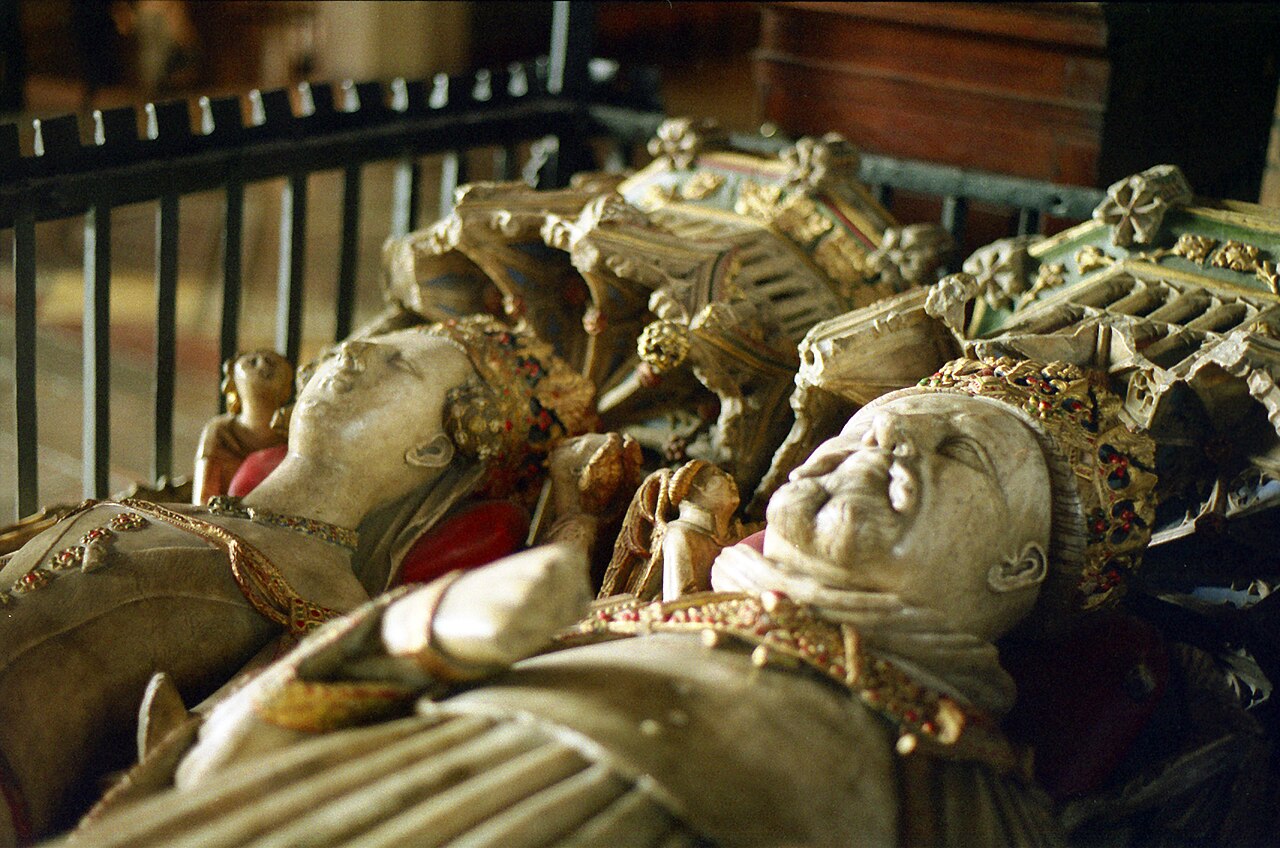The Tomb of Henry IV and Joan of Navarre, Canterbury Cathedral
It is sheer coincidence that Marlowe both wrote a play containing two characters named Henry IV and Jeanne de Navarre and was also familiar with a tomb chest bearing two effigies, one of a man called Henry IV and the other of a woman called Jeanne de Navarre. There were, moreover, significant differences between the two couples: the Henri IV of The Massacre at Paris was a king of France and he and Jeanne d’Albret were mother and son, while the effigies in Canterbury Cathedral are of King Henry IV of England and his second wife. Putting these two Henry/Jeanne pairings in dialogue with each other is however suggestive, because each features a woman accused of deviance (Jeanne d’Albret was a Huguenot and the English queen was accused of trying to kill her stepson Henry V through witchcraft) and each also implicitly invites us to consider how power is lost and gained.
Jeanne de Navarre, Queen of England, married Jean de Montfort, Duke of Brittany, in 1382 and bore him eight children before his death in 1399. In 1402 she married Henry IV of England, a widower with six children, and in 1403, having moved to England to live with him, she was deposed as Regent of Brittany. Henry IV died in 1413, eleven years after their marriage, and was succeeded by his son Henry V, who at first seemed to have a very good relationship with his stepmother. However in 1419 Henry V turned against Jeanne, accused her of witchcraft, and imprisoned in Pevensey Castle, almost certainly because he wanted an excuse for confiscating her very generous dower monies.[i] He relented six weeks before his death in 1422 and released her.
Jeanne d’Albret, Queen of Navarre, lived from 1528-72. Like her namesake, she too married twice. Her first husband, whom she married under protest in 1541, was William, Duke of Julich-Cleves-Berg, but the marriage was annulled in 1545 on grounds of non-consummation. Three years later, in 1548, she married Antoine de Bourbon; their son, the future Henri IV of France, was born in 1553, and two years later, in 1555, she became Queen of Navarre on the death of her father. In 1560 she converted to Calvinism and two years later, in 1562, Antoine de Bourbon died. She outlived him by ten years, dying on 9 June 1572 – in Marlowe’s version, as a result of being sent a poisoned glove, an event which he directly connects to the St Bartholomew’s Day Massacre on 24 August.
Conflicts with which we might consider queens named Jeanne de Navarre to be connected thus include the Wars of the Roses, the Hundred Years War and the Wars of Religion, not to mention the specific link to the St Bartholomew’s Day Massacre. Both queens’ stories also remind us that succession to crowns is an inherently political question subject equally to chance and to acts of skulduggery. Early modern monarchs might regard themselves as divinely appointed, but no reader of either history or Marlowe could believe for long in such an idea, and nor could they fail to notice that the question of whether women could or could not succeed as queens regnant was local and arbitrary in a way that meant it could not possibly be the result of divine guidance or intention. Instead we see both in The Massacre at Paris and in the story which lies behind the Canterbury tomb a chain of arbitrary accessions to the throne which were all plainly the result of either political engineering or outright usurpation. The Jeanne de Navarre who was buried in Canterbury Cathedral was the wife of Henry IV, a man who deposed his cousin Richard II and also incidentally laid the ground for the Wars of the Roses, where a crucial issue was whether the crown of England could be passed by descent from women. But while Henry V’s claim to the English throne was based on excluding women’s rights to the succession, his claim to the French throne depended on admitting them: its sole basis lay in the fact that he was descended from Isabella, daughter of Philip IV of France and wife of Edward II of England. Far from being ‘no king of England if not king of France’, logic demanded that he could not possibly be king of both. If we also remember that the Jeanne who was buried in Canterbury Cathedral was accused of witchcraft we might be further reminded of the Hundred Years War through her sharing of a name with Joan of Arc (whose story Marlowe may have treated in his share of Henry VI, Part One).[ii]
The Jeanne de Navarre who features in The Massacre at Paris is an index of an equally arbitrary and irrational set of succession rules. Her status as queen regnant may seem anomalous in the light of France’s famous prohibition of female succession; however not only was Navarre an independent kingdom in its own right but it had been almost forced to allow female succession as a way of accommodating a difficult problem which had arisen during the reign of King Louis X of France, whose wife was convicted of adultery and whose only child from that marriage, a daughter named Jeanne, was therefore of doubtful legitimacy. Rather than alienate the relatives of his first wife Louis declared that the Salic Law precluded Jeanne’s succession to the throne of France but allowed her to inherit Navarre, which had come to him through his mother. It was because of this precedent that the Jeanne who features in The Massacre at Paris succeeded to the throne of Navarre in her own right as only surviving child of her father (she had nothing to do with her son Henry IV’s claim to the throne of France, which came through his father Antoine de Bourbon).
The adultery of King Louis’ wife also had repercussions in England. Louis was the eldest brother of Isabella, wife of Edward II and mother of Edward III, and after the deaths of Louis himself and his two younger brothers Edward III claimed the French throne on the grounds of his descent from Isabella and launched the Hundred Years War. The presence of a character named Jeanne de Navarre in The Massacre at Paris thus forges a link to Edward II and prepares for the explicit articulation towards the end of Massacre that there is a connection between what happens in France and what happens in England. The tomb chest of Henry IV and Jeanne de Navarre, which Marlowe would have seen during his childhood and which almost certainly afforded him his first visual images of a king and queen, is a concrete reminder of that connection.
Lisa Hopkins
Sheffield Hallam University
[i] Elena Woodacre, Joan of Navarre: Infanta, Duchess, Queen, Witch? (London: Routledge, 2022), p. 116.
[ii] For an overview of views on the authorship question and Joan’s relationship to the rest of the Marlowe canon see M. L. Stapleton, ‘Marlovian Joan la Pucelle’, Journal of Marlowe Studies 1 (2020): 122-144.




Recent Comments